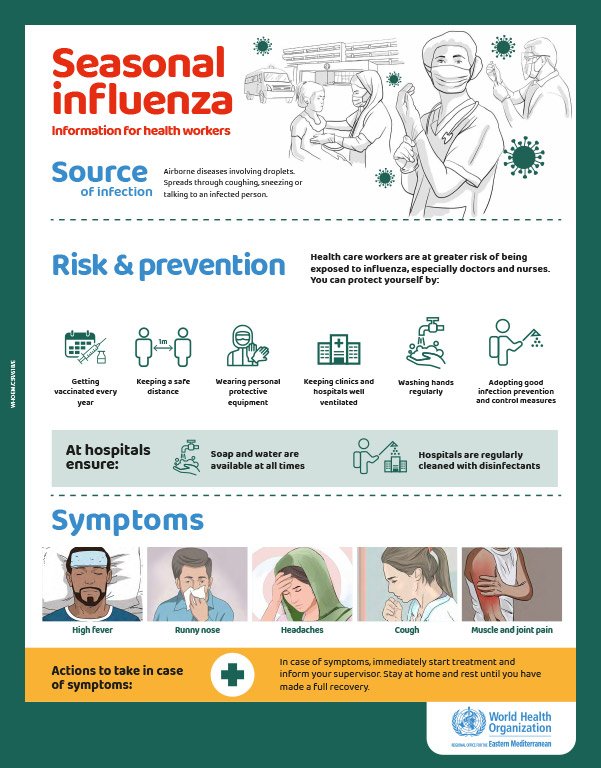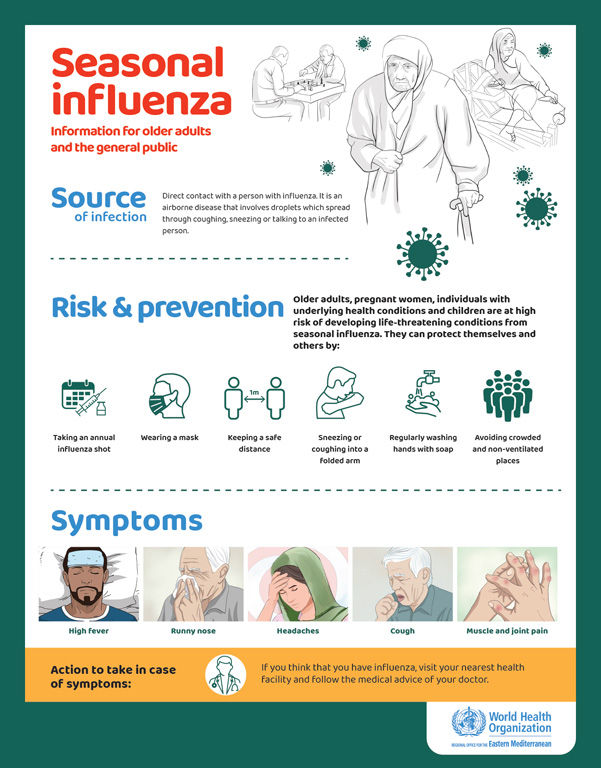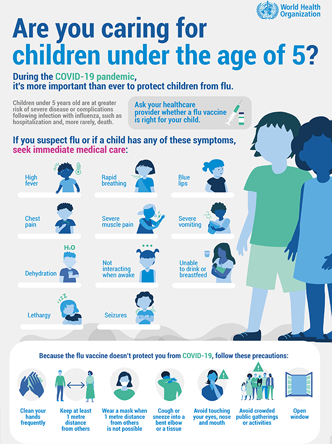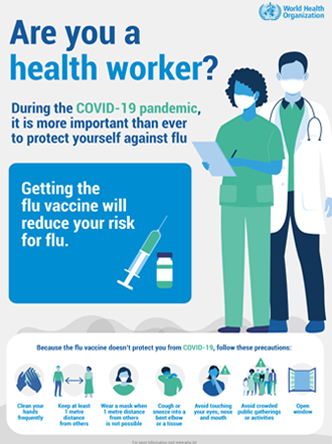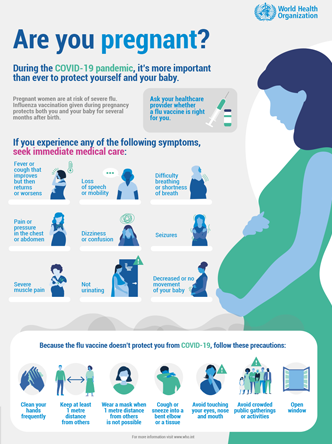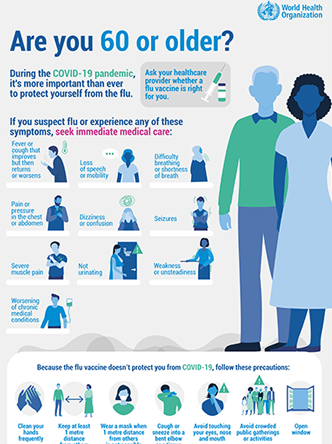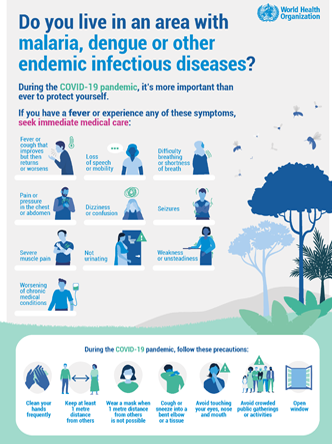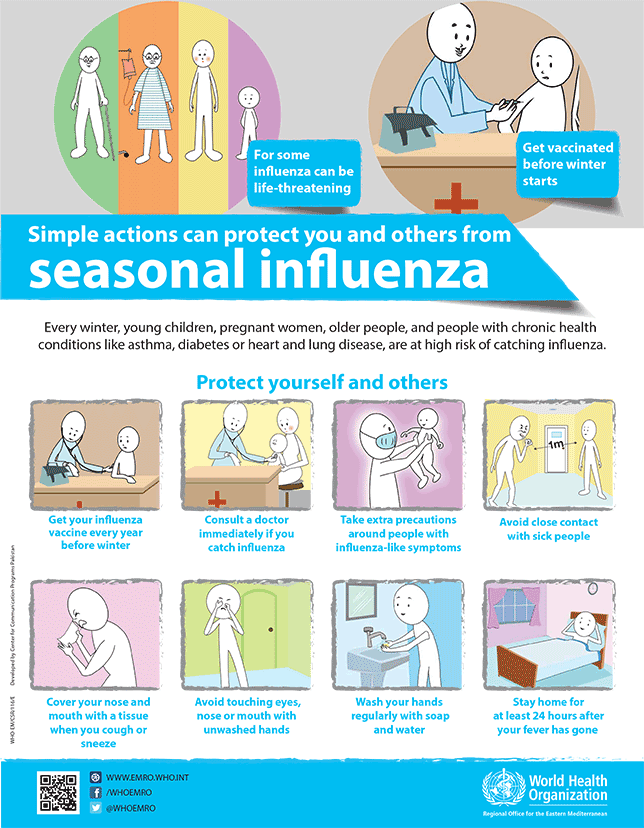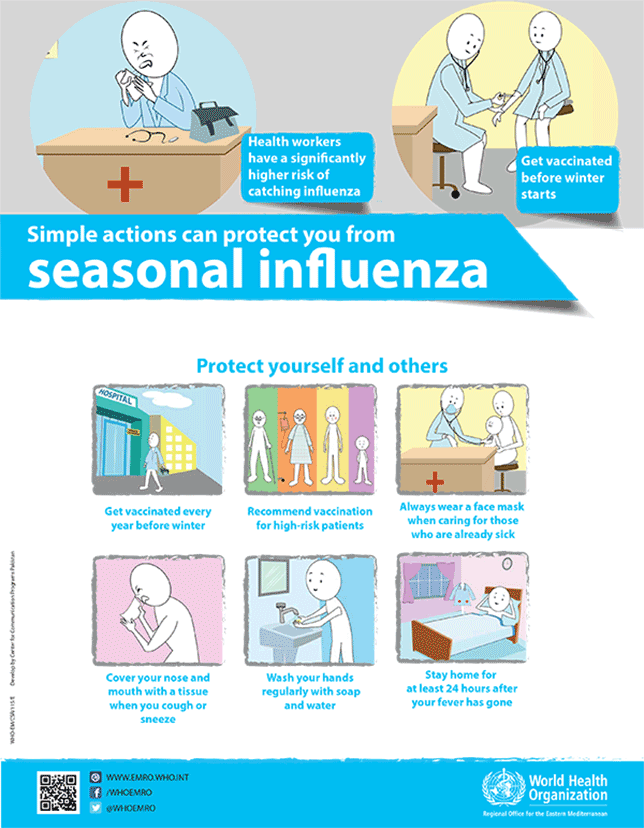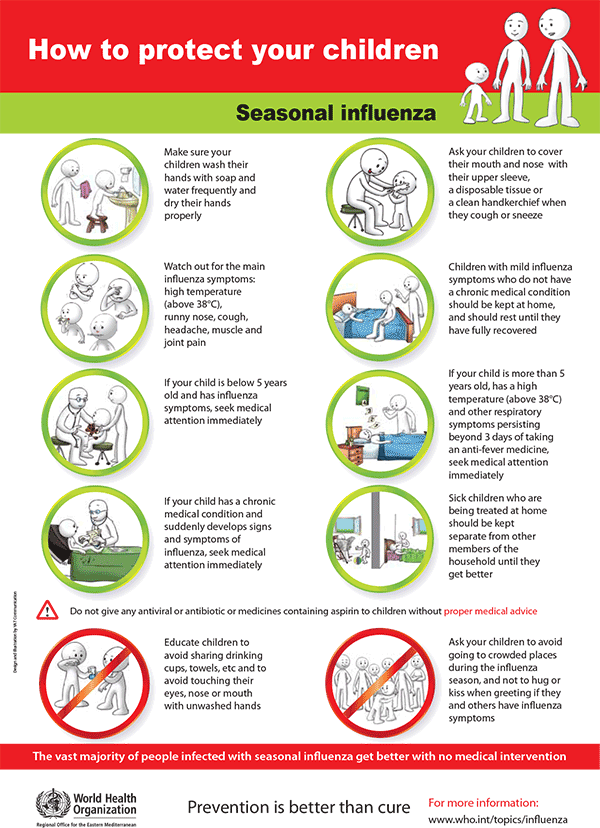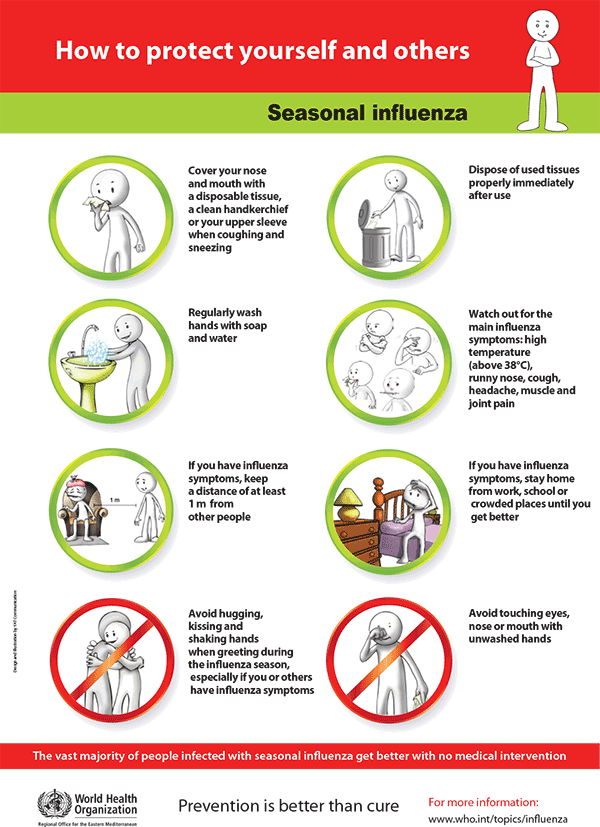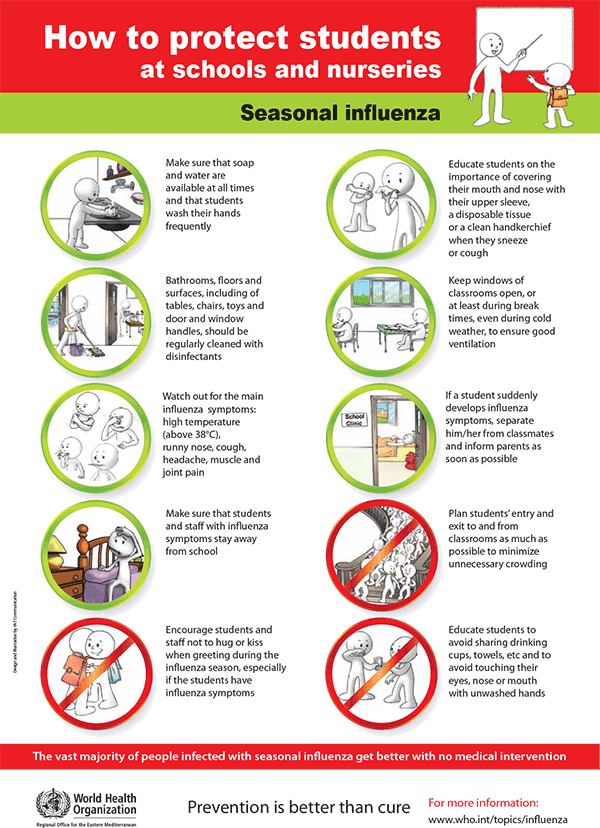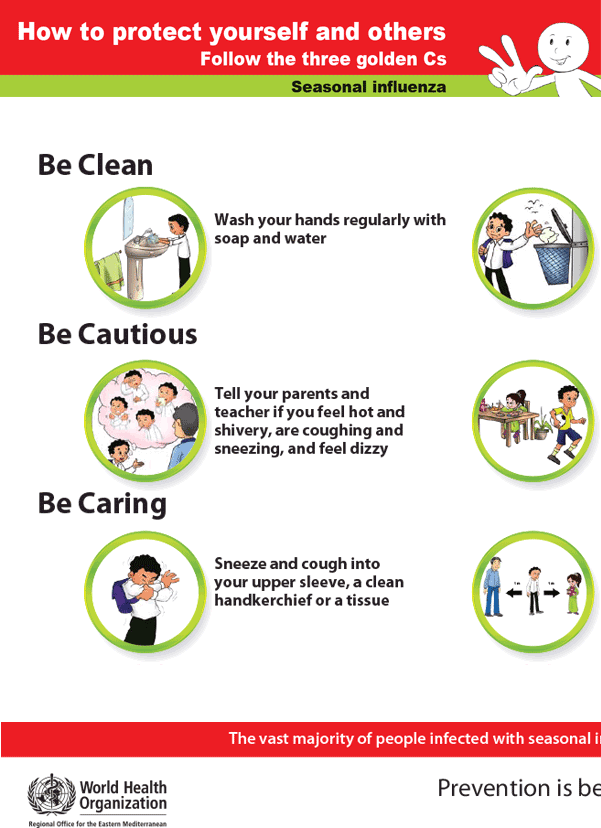Infographics
Flyers
Simple actions can protect you from seasonal influenza
Prevention is better than cure
Videos
Factsheet
Seasonal influenza is an acute respiratory infection caused by influenza viruses which circulate in all parts of the world.
The influenza virus
There are 4 types of seasonal influenza viruses, types A, B, C and D. Influenza A and B viruses are the most common and cause seasonal epidemics of disease globally (1). In temperate regions, both influenza A and B cause winter epidemics, with sporadic cases and outbreaks occurring out of season. In tropical regions such as the Eastern Mediterranean Region, the circulation of influenza viruses ranges from a seasonal peak from October to May to sporadic cases throughout the year.
Influenza A viruses are further classified into subtypes according to the combinations of the hemagglutinin (HA) and the neuraminidase (NA), the proteins on the surface of the virus. Currently circulating in humans are subtype A(H1N1) and A(H3N2) influenza viruses. The A(H1N1) is also written as A(H1N1)pdm09 as it caused the pandemic in 2009 and subsequently replaced the seasonal influenza A(H1N1) virus which had circulated prior to 2009. Only influenza type A viruses are known to have caused pandemics.
Influenza B viruses are not classified into subtypes but can be broken down into lineages. Currently circulating influenza type B viruses belong to either B/Yamagata or B/Victoria lineage.
Influenza C virus is detected less frequently and usually causes mild infections, thus does not present public health importance.
Influenza D viruses primarily affect cattle and are not known to infect or cause illness in people.
Signs and symptoms
Seasonal influenza is characterized by a sudden onset of fever, cough (usually dry), headache, muscle and joint pain, severe malaise (feeling unwell), sore throat, and a runny nose. The cough can be severe and can last 2 or more weeks. Most people recover from fever and other symptoms within a week without requiring medical attention. But influenza can cause severe illness or death, especially in people at high risk.
Illnesses range from mild to severe and even death. Hospitalization and death occur mainly among high-risk groups. Worldwide, these annual epidemics are estimated to result in about 3 to 5 million cases of severe illness, and about 290 000 to 650 000 respiratory deaths.
The effects of seasonal influenza epidemics in developing countries are not fully known, but research estimates that 99% of deaths in children under 5 years of age with influenza-related lower respiratory tract infections are found in developing countries (2).
Diagnosis
The majority of cases of human influenza are clinically diagnosed. However, during periods of low influenza activity and outside of epidemics situations, the infection of other respiratory viruses e.g. rhinovirus, respiratory syncytial virus, parainfluenza and adenovirus can also present as Influenza-like Illness (ILI) which makes the clinical differentiation of influenza from other pathogens difficult.
Collection of appropriate respiratory samples and the application of a laboratory diagnostic test is required to establish a definitive diagnosis. Proper collection, storage and transport of respiratory specimens is the essential first step for laboratory detection of influenza virus infections. Laboratory confirmation of influenza virus from throat, nasal and nasopharyngeal secretions or tracheal aspirate or washings is commonly performed using direct antigen detection, virus isolation, or detection of influenza-specific RNA by reverse transcriptase-polymerase chain reaction (RT-PCR).
Various guidance on laboratory techniques is published and updated by WHO (3). Rapid influenza diagnostic tests (RIDTs) are used in clinical settings, but they have lower sensitivity compared to RT-PCR methods and their reliability depends largely on the conditions under which they are used.
Treatment
Patients that are not from a high-risk group should be managed with symptomatic treatment and are advised, if symptomatic, to stay home in order to minimize the risk of infecting others in the community. Treatment focuses on relieving symptoms of influenza such as fever. Patients should monitor themselves to detect if their condition deteriorates and seek medical attention Patients that are known to be in a group at high risk for developing severe or complicated illness, should be treated with antivirals in addition to symptomatic treatment as soon as possible.
Patients with severe or progressive clinical illness associated with suspected or confirmed influenza virus infection (i.e. clinical syndromes of pneumonia, sepsis or exacerbation of chronic underling diseases) should be treated with antiviral drug as soon as possible.
Neuraminidase inhibitors (i.e. oseltamivir) should be prescribed as soon as possible (ideally, within 48 hours following symptom onset) to maximize therapeutic benefits. Administration of the drug should also be considered in patients presenting later in the course of illness.
Treatment is recommended for a minimum of 5 days but can be extended until there is satisfactory clinical improvement.
Corticosteroids should not be used routinely, unless indicated for other reasons (eg: asthma and other specific conditions); as it has been associated with prolonged viral clearance, immunosuppression leading to bacterial or fungal superinfection.
All currently circulating influenza viruses are resistant to adamantane antiviral drugs (such as amantadine and rimantadine), and these are therefore not recommended for monotherapy.
WHO Global Influenza Surveillance and Response System (GISRS) monitors resistance to antivirals among circulating influenza viruses to provide timely guidance for antiviral use in clinical management and potential chemoprophylaxis.
Epidemiology
People of all age groups can be affected but there are groups that are more at risk than others.
People at greater risk of severe disease or complications when infected are: pregnant women, children under 59 months, older adults (aged more than 65 years), individuals with chronic medical conditions (such as chronic cardiac, pulmonary, renal, metabolic, neurodevelopmental, liver or hematologic diseases) and individuals with immunosuppressive conditions (such as HIV/AIDS, receiving chemotherapy or steroids, or malignancy).
Health care workers are at high risk acquiring influenza virus infection due to increased exposure to the patients and risk further spread particularly to vulnerable individuals.
In terms of transmission, seasonal influenza spreads easily, with rapid transmission in crowded areas including schools and nursing homes. When an infected person coughs or sneezes, droplets containing viruses (infectious droplets) are dispersed into the air and can spread up to one meter, and infect persons in close proximity who breathe these droplets in. The virus can also be spread by hands contaminated with influenza viruses. The time from infection to illness, known as the incubation period, is about 2 days, but ranges from 1 to 4 days. Shedding of virus in infants and young children often starts shortly before symptoms and can continue into the second week of symptoms, while in adults, shedding of virus may only last a few days. To prevent transmission, people should cover their mouth and nose with a tissue when coughing and wash their hands regularly.
Prevention
The most effective way to prevent the disease is vaccination. Flu vaccination prevents tens of thousands of severe cases and flu-related hospitalizations globally every year. Safe and effective vaccines are available and have been used for more than 60 years. Immunity from vaccination wanes over time and circulating strains change, so annual vaccination is recommended to protect against influenza. Injected inactivated influenza vaccines are most used throughout the world.
Among healthy adults, influenza vaccine provides protection, even when circulating viruses do not exactly match the vaccine viruses. However, among the elderly, influenza vaccination may be less effective in preventing illness but reduces the severity of the disease and the incidence of complications and deaths. Vaccination is especially important for people at high risk of influenza complications and for people who live with or care for the people at high risk.
WHO recommends annual vaccination for:
pregnant women at any stage of pregnancy
children aged between 6 months to 5 years
older adults (aged more than 65 years)
individuals with chronic medical conditions
health-care workers.
Influenza vaccine is most effective when circulating viruses are well-matched with viruses contained in vaccines.
For many years, WHO has updated its recommendation on the composition of the vaccine (trivalent) that targets the 3 most representative virus types in circulation (2 subtypes of influenza A viruses and one influenza B virus). Starting with the 2013–2014 northern hemisphere influenza season, a fourth component is recommended to support quadrivalent vaccine development. Quadrivalent vaccines include a 2nd influenza B virus in addition to the viruses in trivalent vaccines and are expected to provide wider protection against influenza B virus infections. A number of inactivated influenza vaccines and recombinant influenza vaccines are available in injectable form. Live attenuated influenza vaccine is available as a nasal spray.
Pre-exposure or post-exposure prophylaxis with antivirals is possible but depends on several factors e.g. individual factors, type of exposure, and risk associated with the exposure.
Apart from vaccination and antiviral treatment, the public health management includes personal protective measures like:
Regular hand washing with proper drying of the hands
Good respiratory hygiene – covering mouth and nose when coughing or sneezing, using tissues and disposing of them correctly
Early self-isolation of those feeling unwell, feverish and having other symptoms of influenza
Avoiding close contact with sick people
Avoiding touching one’s eyes, nose or mouth
Wearing masks in crowded indoor or outdoor settings where physical distancing is not possible
Staying home from work or school if feeling sick.
WHO support to countries for influenza management
WHO, through the WHO Global Influenza Surveillance and Response System (GISRS) system, in collaboration with other partners, monitors influenza activity globally, recommends seasonal influenza vaccine compositions twice a year for the northern and southern hemisphere influenza seasons, guides countries in tropical and subtropical areas to choose vaccine formulations (northern hemisphere versus southern hemisphere), to support decisions for timing of vaccination campaigns, and to support countries to develop prevention and control strategies.
WHO works to strengthen national, regional and global influenza response capacities including diagnostics, antiviral susceptibility monitoring, disease surveillance and outbreak responses, and to increase vaccine coverage among high-risk groups and prepare for the next influenza pandemic.
(1) Estimates of US influenza-associated deaths made using four different methods. Thompson WW, Weintraub E, Dhankhar P, Cheng OY, Brammer L, Meltzer MI, et al. Influenza Other Respi Viruses. 2009;3:37-49.
(2) Global burden of respiratory infections due to seasonal influenza in young children: a systematic review and meta-analysis. (Nair H, Abdullah Brooks W, Katz M et al. Lancet 2011; 378: 1917–3.
(3) WHO recommended surveillance standards, Second edition.
Data
Global influenza strategy 2019-2030
FluID – a global influenza epidemiological data sharing platform
GISRS – Global influenza surveillance and response System
FluNet – a tool for global influenza virological surveillance
Technical guidance
- Global influenza strategy 2019-2030
- WHO Position Paper for use of influenza vaccines (May 2022)
- Manual for estimating economic burden of seasonal influenza and training
- Guidance on the economic evaluation of influenza vaccination
- WHO Flutool plus – seasonal influenza immunization costing tool (SIICT) and training
- OpenWHO influenza courses
- List of WHO List of WHO prequalified vaccines
- WHO Vaccine Product, Price and WHO Vaccine Product, Price and Procurement (V3P) Platform
- Overview of seasonal influenza vaccines
- How to implement seasonal influenza vaccination of health workers
- How to implement influenza vaccination of pregnant women
- Principles and considerations for adding a vaccine to a national immunization programme
- Pandemic Influenza Preparedness (PIP) Framework
- Revision of clinical case definitions: influenza-like illness and severe acute respiratory infection (2018)
- Global Influenza Surveillance and Response System (GISRS)



